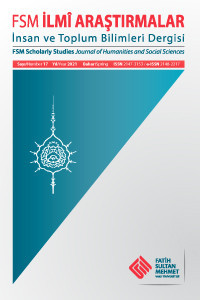Büyük Selçuklu Mimarisinde Avlu Kimliği
Avlu; Selçuklu Mimarisi; Kimlik; Mimarlık Psikolojisi
Courtyard Identity within the Architecture of the Great and Anatolian Seljuks
- ISSN: 2147-3153
- Başlangıç: 2012
- Yayıncı: Fatih Sultan Mehmet Vakıf Üniversitesi
M. Fatih Andı, Emperyalizme Direniş Bilinci: Çanakkale
Yaygınlık Bakımından Meallerimiz ve Mealler Üzerinde İstatistiksel Bir Değerlendirme
Sibel A. Arkonaç, Psikolojide Bilginin Eleştirel Arkaplanı
Osmanlı Hariciyesinde Yaklaşık Kırk Yıl: Mahmud Esad Paşa (1837- 1895)
Yasak Bir Hafızayla Yüzleşmek : Menemen Olayı İrtica mı, Komplo mu ?
Sadrettin Gümüş, Seyyid Şerîf Cürcânî ve Arap Dilindeki Yeri
Concept of Barakah in Qur’ān and Sunnah: Towards its Realization in Modern Discourse
Serdar DEMİREL, Hikmatullah Babu SAHİB
Mustafa Kutlu’nun Anadolu Yakası Adlı Eseri Üzerine Metinlerarası İlişkiler Bağlamında Bir İnceleme
Yeni Harb: Başımıza Tekrar Gelenler: Edirne Harbi, Muhasarası, Esâret ve Esbâb-ı Felâket
Yaşar Şâdi Efendi’nin “Hutût-ı Meşâhir” İsimli Hatıra Defteri ve Muhtevası
